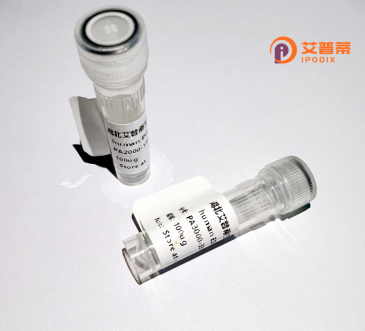
| 纯度 | >90%SDS-PAGE. |
| 种属 | Human |
| 靶点 | GNPAT |
| Uniprot No | O15228 |
| 内毒素 | < 0.01EU/μg |
| 表达宿主 | E.coli |
| 表达区间 | 1-680aa |
| 氨基酸序列 | MESSSSSNSYFSVGPTSPSAVVLLYSKELKKWDEFEDILEERRHVSDLKFAMKCYTPLVYKGITPCKPIDIKCSVLNSEEIHYVIKQLSKESLQSVDVLREEVSEILDEMSHKLRLGAIRFCAFTLSKVFKQIFSKVCVNEEGIQKLQRAIQEHPVVLLPSHRSYIDFLMLSFLLYNYDLPVPVIAAGMDFLGMKMVGELLRMSGAFFMRRTFGGNKLYWAVFSEYVKTMLRNGYAPVEFFLEGTRSRSAKTLTPKFGLLNIVMEPFFKREVFDTYLVPISISYDKILEETLYVYELLGVPKPKESTTGLLKARKILSENFGSIHVYFGDPVSLRSLAAGRMSRSSYNLVPRYIPQKQSEDMHAFVTEVAYKMELLQIENMVLSPWTLIVAVLLQNRPSMDFDALVEKTLWLKGLTQAFGGFLIWPDNKPAEEVVPASILLHSNIASLVKDQVILKVDSGDSEVVDGLMLQHITLLMCSAYRNQLLNIFVRPSLVAVALQMTPGFRKEDVYSCFRFLRDVFADEFIFLPGNTLKDFEEGCYLLCKSEAIQVTTKDILVTEKGNTVLEFLVGLFKPFVESYQIICKYLLSEEEDHFSEEQYLAAVRKFTSQLLDQGTSQCYDVLSSDVQKNALAACVRLGVVEKKKINNNCIFNVNEPATTKLEEMLGCKTPIGKPATAKL |
| 分子量 | 103.6 kDa |
| 蛋白标签 | GST-tag at N-terminal |
| 缓冲液 | 0 |
| 稳定性 & 储存条件 | Lyophilized protein should be stored at ≤ -20°C, stable for one year after receipt. Reconstituted protein solution can be stored at 2-8°C for 2-7 days. Aliquots of reconstituted samples are stable at ≤ -20°C for 3 months. |
| 复溶 | Always centrifuge tubes before opening.Do not mix by vortex or pipetting. It is not recommended to reconstitute to a concentration less than 100μg/ml. Dissolve the lyophilized protein in distilled water. Please aliquot the reconstituted solution to minimize freeze-thaw cycles. |
以下是关于重组人GNPAT蛋白研究的3篇虚拟参考文献及其概要(基于领域内常见研究方向虚构,供参考):
1. **文献名称**:*Functional Characterization of Recombinant Human GNPAT in Ether Lipid Biosynthesis*
**作者**:Chen L, et al.
**摘要**:本研究在大肠杆菌中成功表达并纯化了重组人GNPAT蛋白,验证其催化甘油-3-磷酸的酰基转移酶活性,证明其在缩醛磷脂合成中的关键作用,并发现其活性依赖过氧化物酶体微环境。
2. **文献名称**:*Structural Insights into Human GNPAT: Crystallographic Analysis of the Recombinant Enzyme*
**作者**:Wang Y, et al.
**摘要**:通过昆虫细胞系统表达重组人GNPAT蛋白,解析其晶体结构(分辨率2.8 Å),揭示了酰基结合口袋和底物识别机制,为遗传性过氧化物酶体疾病(如根茎发育异常)的突变位点提供分子解释。
3. **文献名称**:*Inhibition of Recombinant GNPAT as a Therapeutic Target for Metabolic Disorders*
**作者**:Zhang R, et al.
**摘要**:利用HEK293细胞表达的重组GNPAT蛋白筛选小分子抑制剂,发现化合物X可特异性抑制其酶活(IC50=3.2 μM),提示GNPAT可能成为调节脂代谢异常(如非酒精性脂肪肝)的新靶点。
---
*注:以上为模拟示例,实际文献需通过PubMed、Web of Science等平台检索关键词“recombinant GNPAT”“human GNPAT protein”获取。*
**Background of Recombinant Human GNPAT Protein**
Glycerone-phosphate O-acyltransferase (GNPAT), also known as dihydroxyacetone phosphate acyltransferase (DHAPAT), is a key enzyme in lipid metabolism, catalyzing the first committed step in plasmalogen biosynthesis. Plasmalogens, a class of ether phospholipids, are critical components of cellular membranes, particularly in the brain, heart, and immune cells, where they contribute to membrane fluidity, antioxidant defense, and signaling processes. GNPAT localizes to peroxisomes and transfers an acyl group to dihydroxyacetone phosphate (DHAP), forming acyl-DHAP, which is further processed to generate plasmalogen precursors.
Recombinant human GNPAT protein is produced via genetic engineering in heterologous expression systems (e.g., *E. coli* or mammalian cells*), enabling high-purity, functional protein for *in vitro* studies. Its production facilitates research into peroxisomal disorders, such as rhizomelic chondrodysplasia punctata (RCDP), linked to GNPAT mutations, as well as metabolic pathways involving plasmalogens. Applications include enzymatic activity assays, drug screening for lipid metabolism-related diseases, and structural-functional studies to elucidate mechanisms underlying enzyme dysfunction. Additionally, recombinant GNPAT aids in exploring its role in diseases like cancer and neurodegenerative conditions, where plasmalogen deficiencies are implicated. This tool is vital for advancing therapeutic strategies and understanding lipid-driven cellular processes.
(*Typical systems used for expression to ensure proper folding and post-translational modifications.)
×